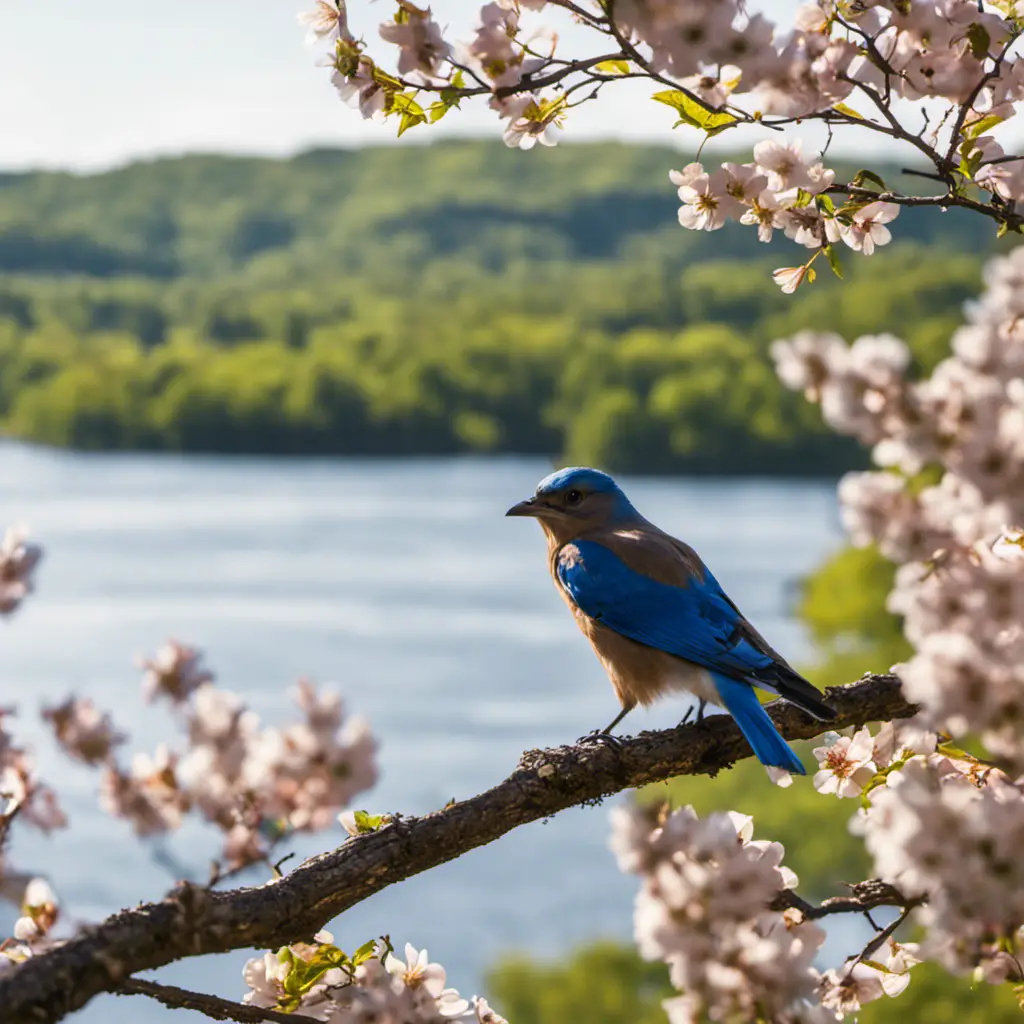We’ll present the most prevalent birds seen in Wyoming with photographs and important data. Only reputable sources were used, and the information was double-checked with an ornithologist.
Common Backyard Birds in Wyoming:
House Finch
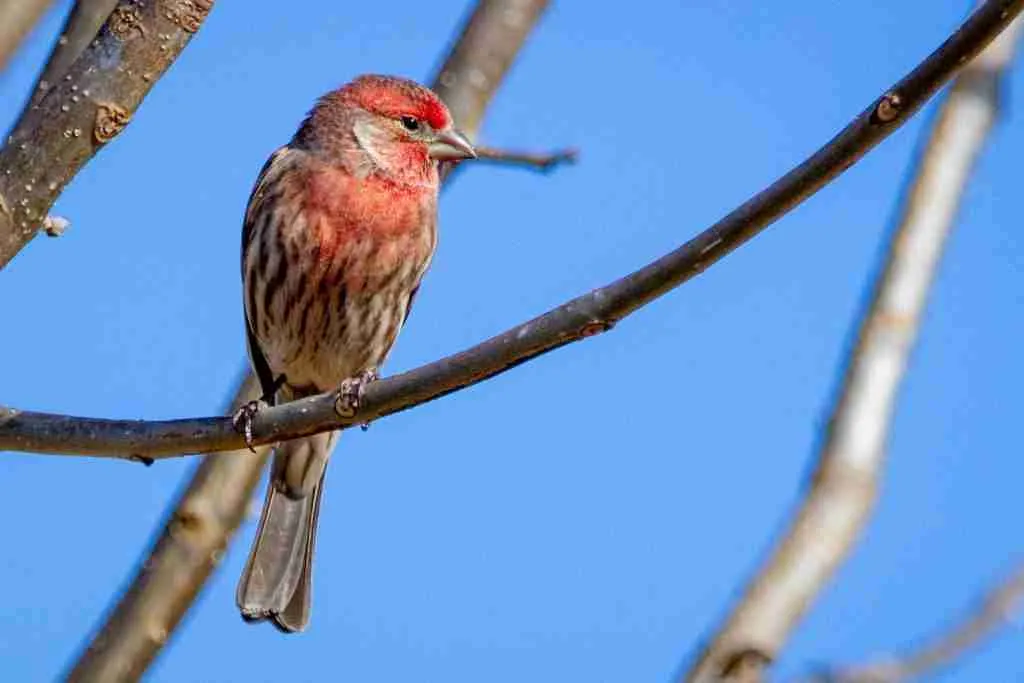
(Haemorhous mexicanus) are small, sparrow-sized birds with a red face and distinctive brown streaking on their chest and back. Their diet consists mainly of black oil sunflower seeds and grains, supplemented by insects during the breeding season.
They can be found in a variety of habitats including urban areas, open woodlands, and grasslands. They typically form monogamous pairs and build cup-shaped nests made of grass, twigs, and other materials.
During the breeding season, males may display aggressive behavior towards intruders near their territory. Overall, House Finches are common and widespread in Wyoming.

Common Grackle
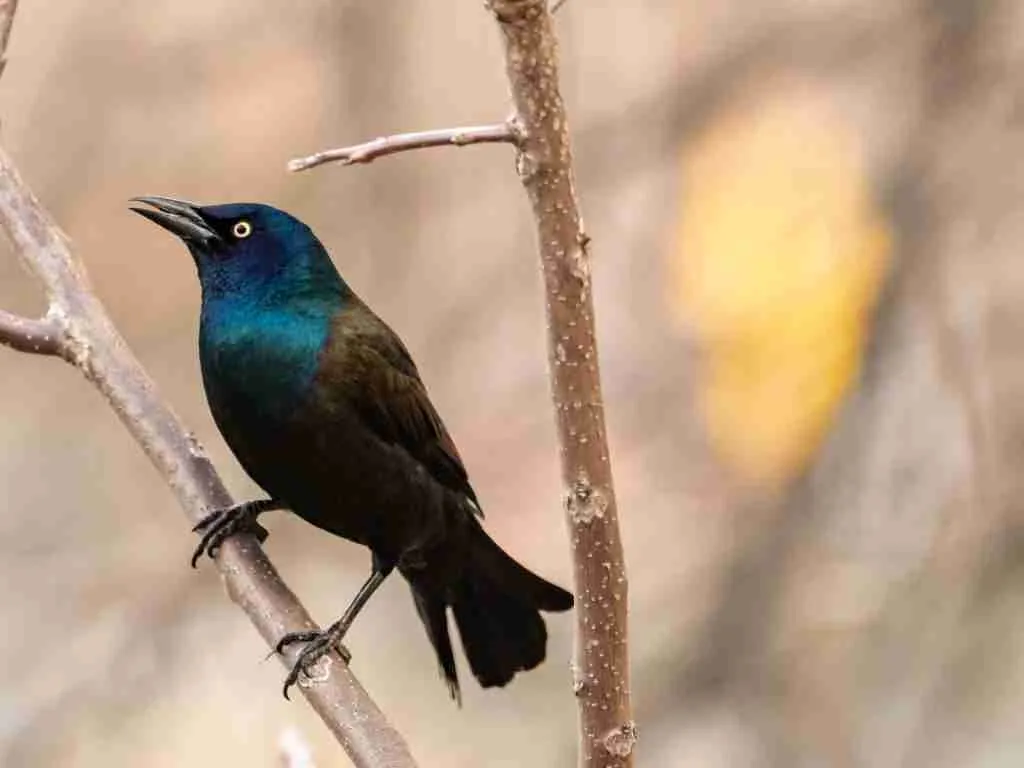
Common Grackle is a medium-sized blackbird with iridescent purple and green plumage. It can often be found foraging on the ground for insects, fruits, and grains in open areas such as fields, parks, and suburban yards.
These birds form large flocks and are known for their noisy vocalizations. They are also known to be aggressive towards other bird species, taking over their nests and feeding areas.
In Wyoming, Common Grackles can be found year-round in open habitats throughout the state. They may also migrate to southern states during the winter months.
Adult Common Grackles have an average length of 11-12 inches and a wingspan of 17-20 inches. They can weigh anywhere from 1.4-2.3 ounces.

Western Meadowlark
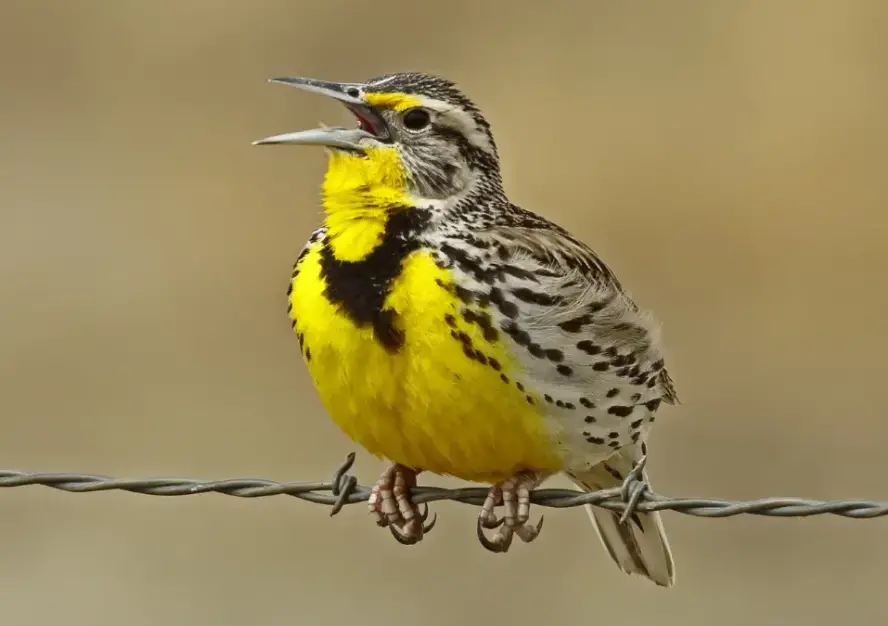
Western Meadowlark is a medium-sized songbird with a bright yellow breast, a black V-shape on the neck, and a white belly. Its diet consists mainly of insects, seeds, and grains. In Wyoming, Western Meadowlarks can typically be found in open grasslands or agricultural areas.
This bird is known for its beautiful flute-like songs that it sings from high perches. During the breeding season, males will perform an aerial display to woo a mate. Both males and females participate in building the nest and caring for their young.
Western Meadowlarks are often seen alone or in small flocks outside of breeding season. They use their long pointed beaks to dig for food in the ground. In winter, they may form large flocks with other meadowlarks and blackbirds.

Mountain Chickadee
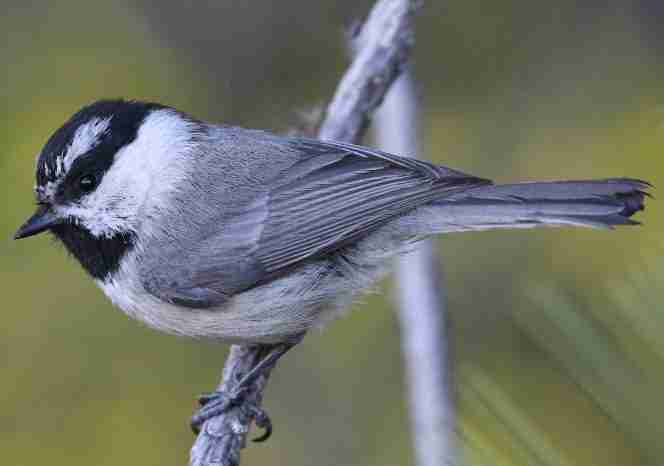
Mountain Chickadees, small black and white bird, is commonly found in the coniferous forests of Wyoming. They have a distinct “chick-a-dee-dee-dee” call and are known for their clever caching habits, storing food items for later retrieval. Their diet consists mainly of insects and seeds.
Mountain Chickadees typically form monogamous pairs and may brood up to two clutches per breeding season. They create nests in tree cavities or nest boxes and will sometimes use moss, feathers, and fur for nesting material.
In winter, Mountain Chickadees often form flocks with other small bird species such as nuthatches and kinglets. These flocks can be spotted foraging together on tree branches or hanging upside down to collect food items.

Pine Siskin
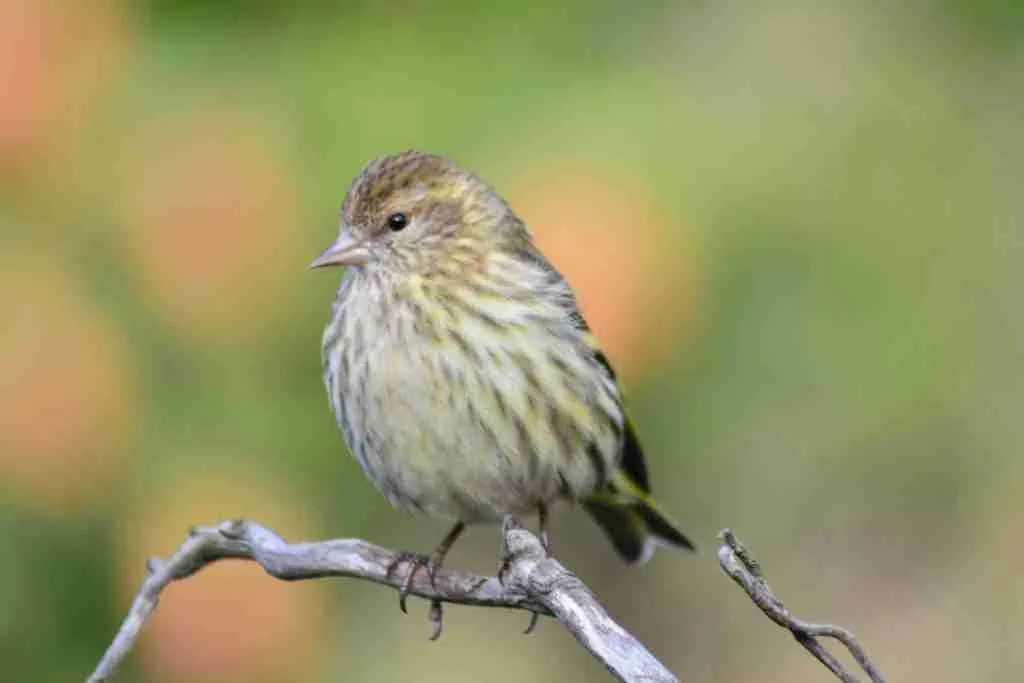
Pine Siskin is a small finch with a yellow wash on its wings and tail, as well as streaks on its breast. Its diet consists mainly of seeds and occasional insects. In Wyoming, it can be found in coniferous forests or urban areas in the wintertime.
This bird is known for its sociability and often travels in flocks with other finches. It is also known for its acrobatic feeding behavior, hanging upside down while searching for food. In the summer, it can be found in higher elevation coniferous forests where it nests.

Dark-eyed Junco
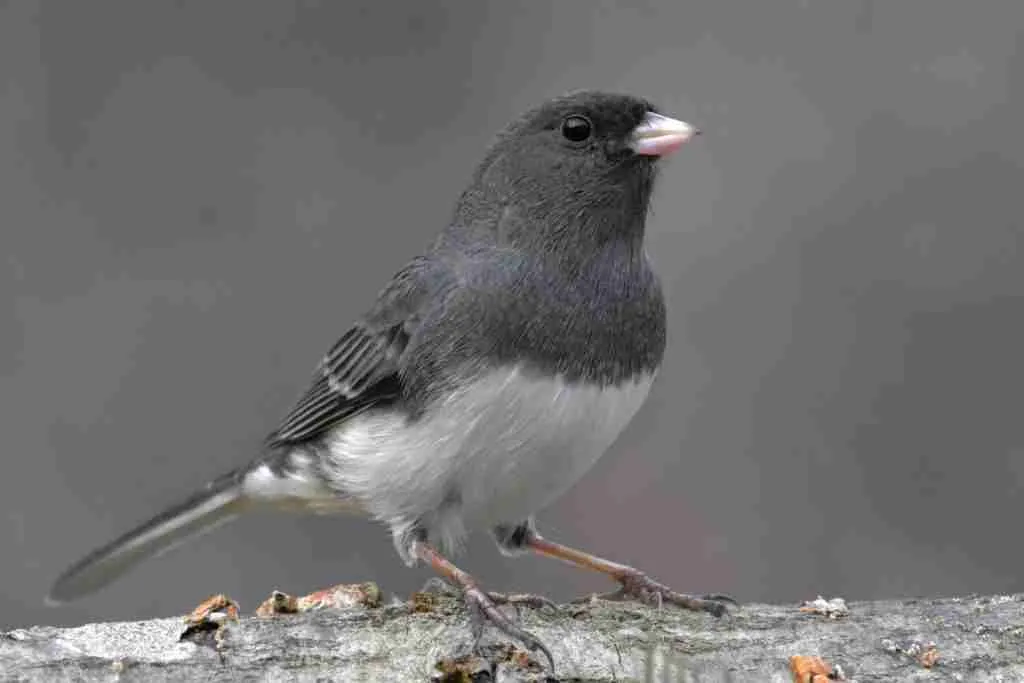
Dark-eyed Junco is a small songbird with a rounded body and long tail. Its upperparts are gray, while its underparts are white with dark streaks. It has a distinct white eyebrow and dark eyes.
In Wyoming, Dark-eyed Juncos can be found in coniferous forests and high mountain meadows. They primarily feed on seeds and insects.
In their social behavior, Dark-eyed Juncos form flocks and can often be seen hopping on the ground in search of food. They have a variety of musical songs and calls. During breeding season, they display aggression towards other juncos and defend their territory.
The average length of a Dark-eyed Junco is 6-6.5 inches and they weigh about 0.7 ounces.

Violet-green Swallow
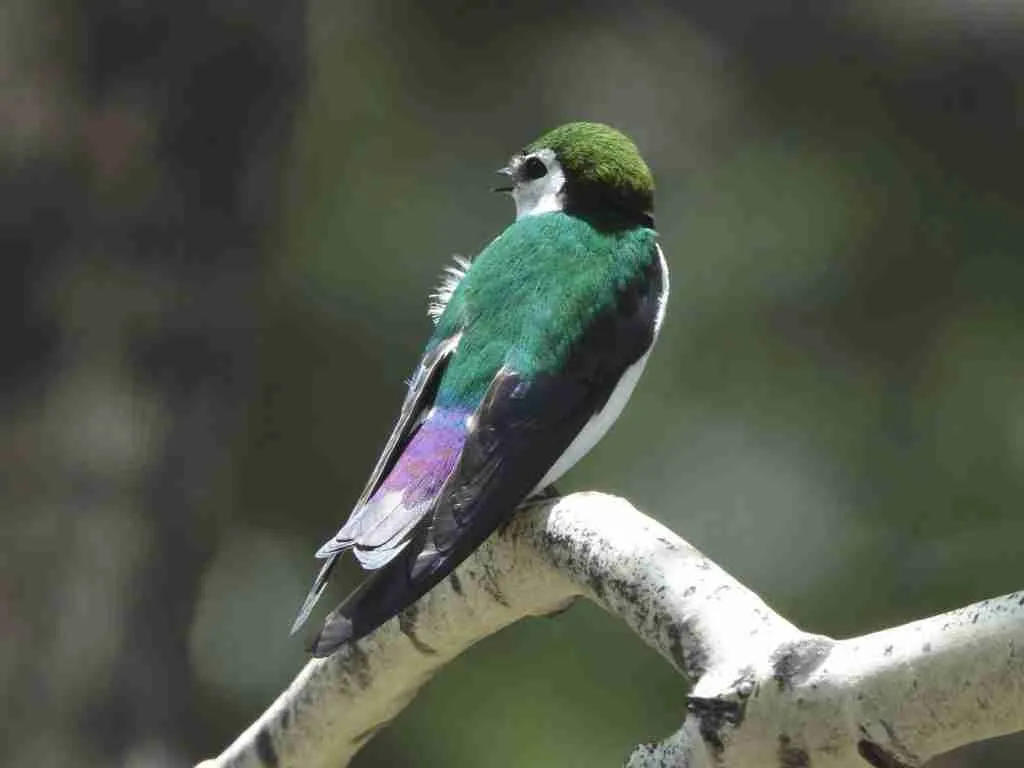
Violet-green Swallow is a small bird with glossy green-blue upperparts, white underparts, and a forked tail. Its diet consists mainly of flying insects which it catches in flight.
In Wyoming, this migratory bird can be found in open woodlands near water sources. During breeding season, these birds often form large colony nests made of mud and grass, often on cliff faces or buildings.
Outside of breeding season, Violet-green Swallows can be seen in flocks, flying and foraging for food together. They are agile and acrobatic flyers, easily maneuvering through the air to catch insects.
During courtship displays, pairs will fly high in the air, performing aerial twists and turns before diving back down to the nest.

White-crowned Sparrow
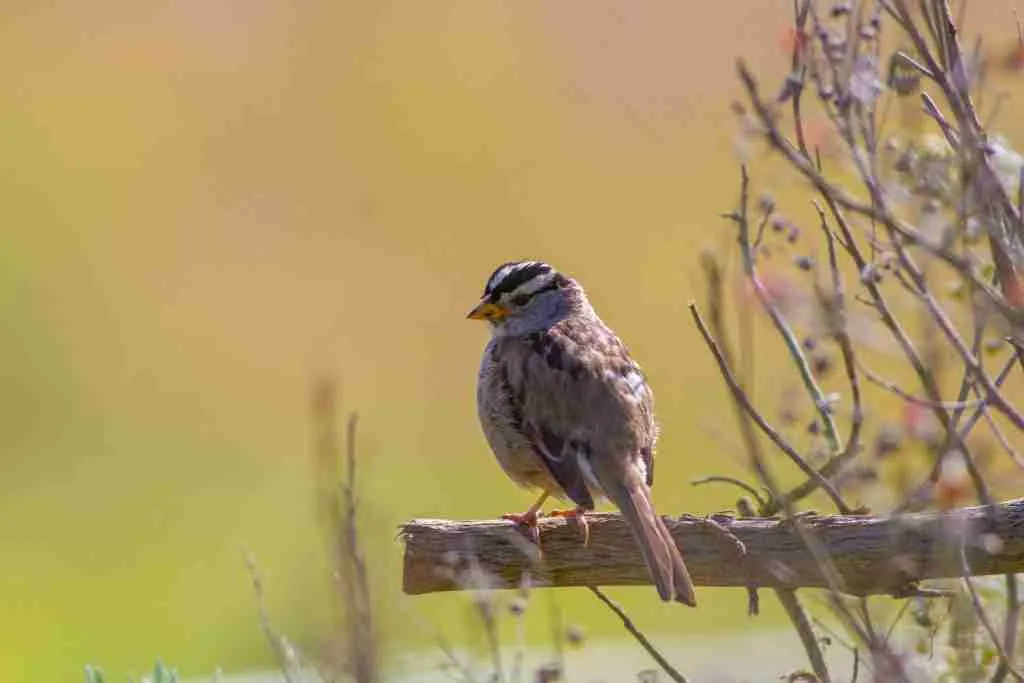
White-crowned Sparrows can be identified by their striped head and chest, yellow beak, and dark brown wings. Their diet consists mainly of seeds and insects. They are small birds, measuring about 6-7 inches in length.
In Wyoming, White-crowned Sparrows can typically be found in open conifer forests or meadows.
They often forage on the ground and can sometimes be spotted in flocks with other sparrow species. During breeding season, they are known to have a low, whistling song. Otherwise, their calls are described as trills or chirps.
These sparrows typically breed in northern regions and migrate south for the winter months. However, some may stay in Wyoming if there is an abundance of food and suitable habitat.

Northern Flicker
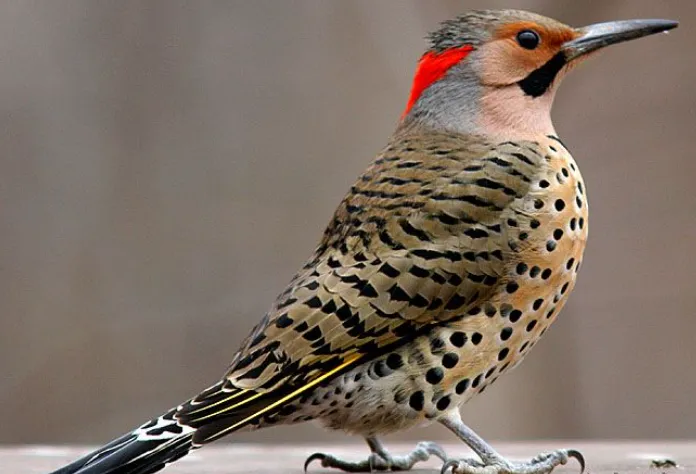
Northern Flicker woodpeckers can be identified by their brown barred backs, black bibs, and spotted underbellies. These birds mostly feed on insects they find by digging into wood, but they also eat fruits and berries.
Northern Flickers typically grow to be around 12 inches in length with a wingspan of 18-20 inches. They are commonly found in open woodlands and forest edges. In terms of behavior, Northern Flickers are often seen on the ground, as they forage for food. They also have a distinctive call that sounds like “flick-a, flick-a.”
In Wyoming, Northern Flickers can be found year-round in lower elevations and during the spring and summer in higher elevations. They may also migrate south for the winter in some areas.

Mourning Doves
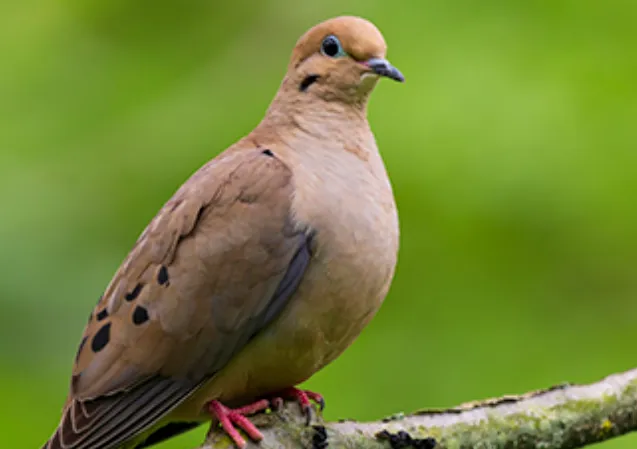
Mourning doves can be identified by their small size, long tail, and soft gray and brown feathers. They primarily eat seeds and grains, though they will also eat insects.
In Wyoming, mourning doves can be found in a variety of habitats including open fields, grasslands, and woodlands.
Mourning doves have a quiet cooing call and generally live solitary lives, except during the breeding season when they form pairs. They build flimsy nests in trees or shrubs to lay their eggs.
Mourning doves are primarily active during the daytime, but may also be seen foraging for food at dawn and dusk. They fly swiftly with quick wing beats and long glides. They also have the ability to drink water without fully landing on the ground, using their beak to scoop up water while hovering.

Red-breasted Nuthatch

Red-breasted Nuthatch, a small songbird with gray upperparts and white underparts, can be found in coniferous forests of Wyoming. They have a black stripe on their heads and a black bill.
Their diet consists mainly of insects and seeds, which they forage for on tree trunks and branches.
Red-breasted Nuthatches are small birds, measuring about 4.5 inches in length and weighing only 0.3 ounces.
In addition to coniferous forests, they can also be found in wooded residential areas and parks.
Red-breasted Nuthatches are known for their acrobatic behavior, often hanging upside down as they search for food on tree trunks and branches. They also have a distinctive call that sounds like a repeated “yank-yank.”
These birds are known to store extra food in tree crevices for later consumption, and they often join mixed species flocks during winter months. They may also use nest cavities left by woodpeckers for nesting.

Red-winged Blackbird
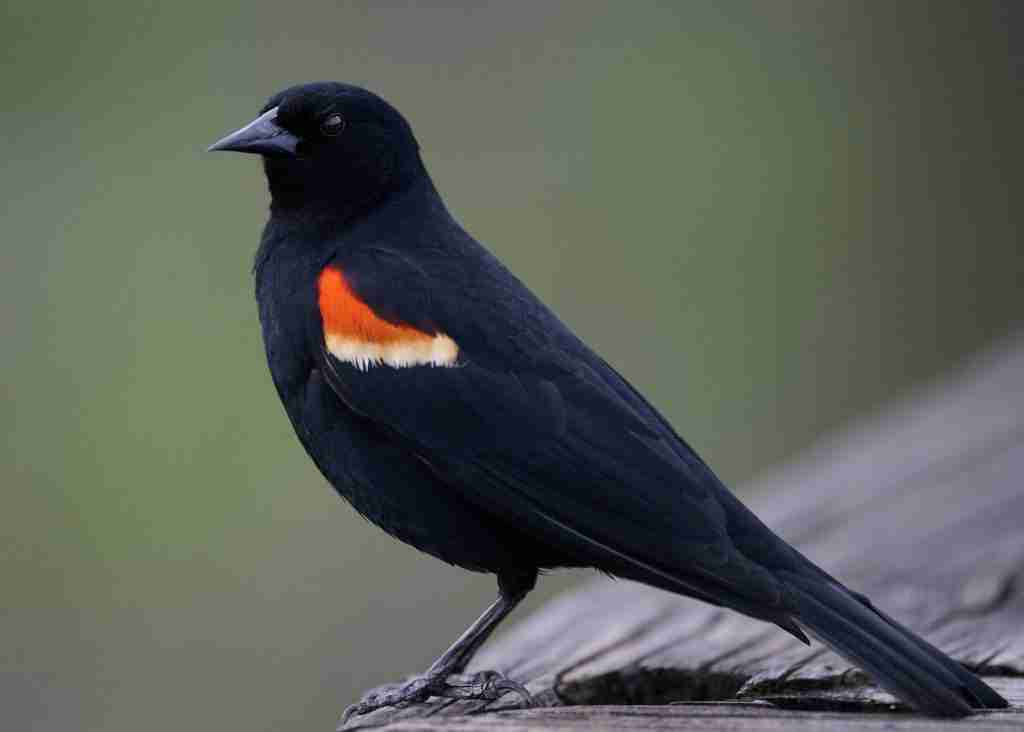
(Agelaius phoeniceus) can be identified by their glossy black feathers and distinct red shoulder patches. These birds primarily feed on insects, grains, and seeds. They range in size from 7-9 inches in length with a wingspan of 12-16 inches.
Red-winged Blackbirds can be found in marshy areas, fields, and along the edges of woodlands. They are known for their territorial behavior and loud vocalizations. During the breeding season, males often perform aerial displays to defend their territory and attract a mate.
In Wyoming, Red-winged Blackbirds can be found throughout the state during the spring and summer months. During winter, they may migrate to southern parts of the United States or even Mexico.

Cliff Swallow
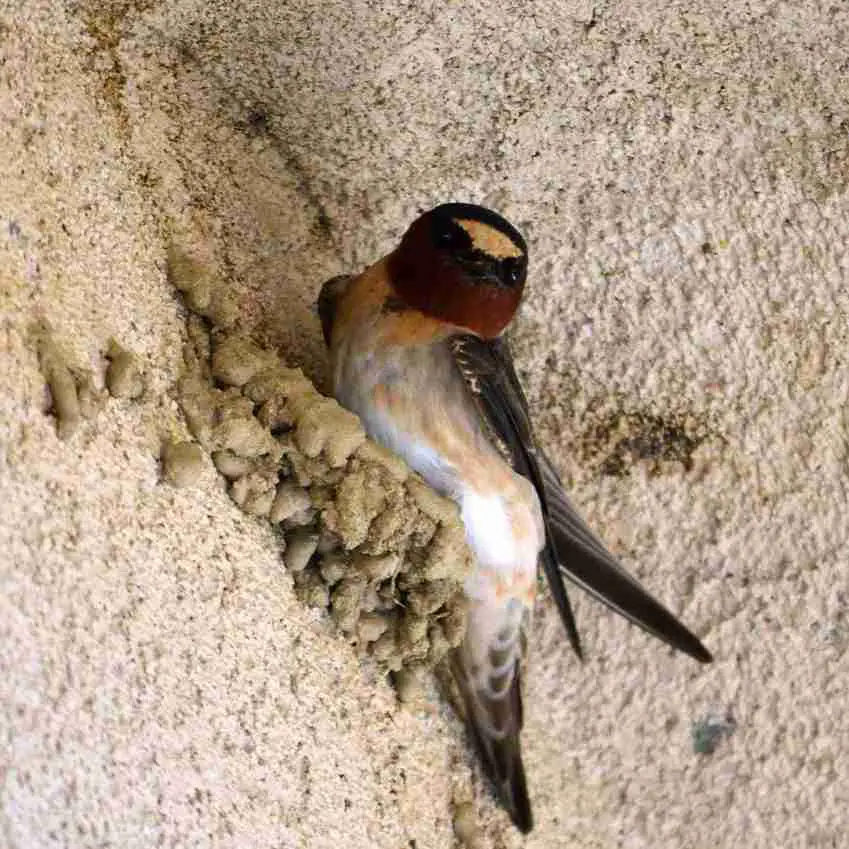
Cliff Swallow, a member of the Hirundinidae family, can be identified by its dark blue upperparts and light brown underparts with a white throat and forehead. This bird primarily feeds on insects, catching them in flight. It measures around 5-6 inches in length with a wingspan of 9-11 inches.
In Wyoming, Cliff Swallows can be found near open habitats such as grasslands and agricultural fields, often building their mud nests on cliffs or human-made structures like bridges.
They are highly social birds, often forming large colonies with other swallows. During the breeding season, they perform aerial displays and vocalizations to attract a mate. Outside of the breeding season, they form flocks and migrate to warmer regions.

Tree Swallows

Tree Swallows, found in Wyoming, have streamlined bodies and iridescent blue-green upperparts. They have white underparts and foreheads with dark, narrow throats.
Their diet consists mainly of flying insects, which they catch in mid-air.
These small birds typically measure around 5 to 6 inches in length and have a wingspan of 8 to 9 inches.
Tree Swallows prefer open habitats, such as meadows, marshes, and shorelines with trees or shrubs for nesting sites.
During the breeding season, they are highly territorial and will defend their nesting area aggressively. Outside of the breeding season, they often gather in large flocks to roost and forage for food.
Tree Swallows migrate in the winter, flying south to spend the colder months in states along the Gulf of Mexico and in Central America.
These birds mate for life and often return to the same nesting site year after year. They construct cup-shaped nests made of grass, moss, and feathers, lining them with soft materials such as fur or wool. Females typically lay a clutch of four to five eggs, which both parents help incubate for about two weeks before they hatch. The young birds fledge and leave the nest after about three weeks.

Mountain Bluebird
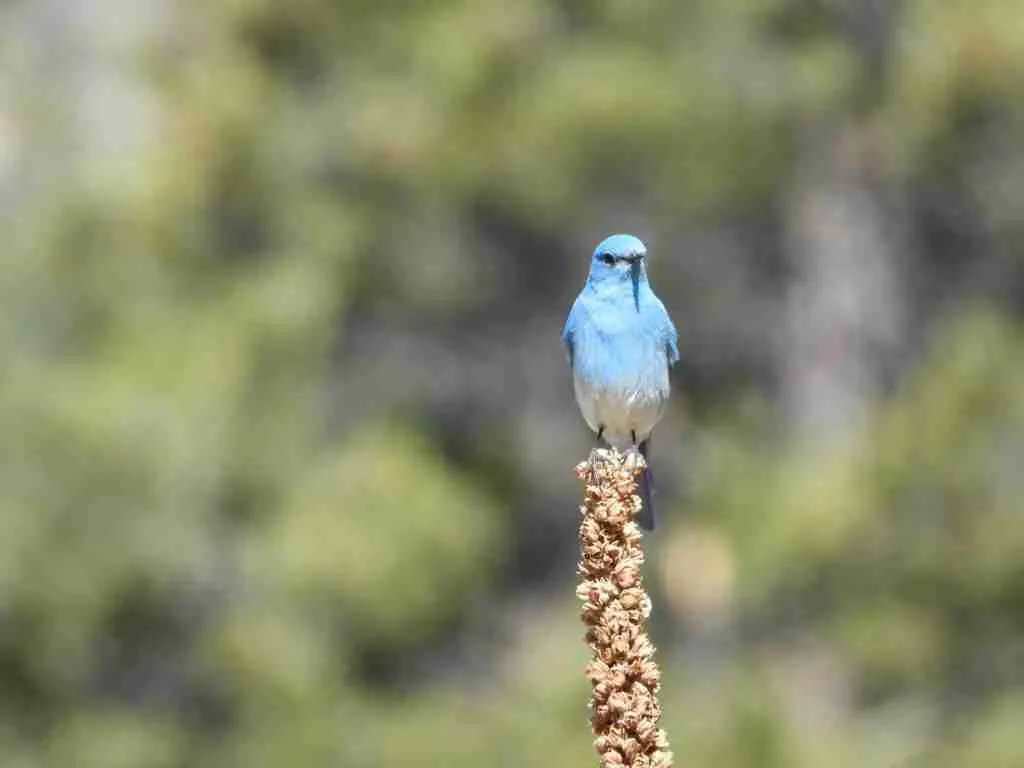
(Sialia currucoides) can be identified by their bright blue feathers and white bellies. They mainly eat insects such as grasshoppers and beetles, but also consume berries and seeds.
These birds typically have a length of about 6-7 inches and can be found in open habitats such as meadows, fields, and mountain slopes. Mountain Bluebirds often perch on telephone wires or fence posts and fly down to catch their prey.
They also have a habit of collecting nesting material, such as grass and feathers, in their beaks before flying back to their nests. In Wyoming, these birds can be spotted during the summer months before migrating south for the winter.

Yellow-rumped Warbler
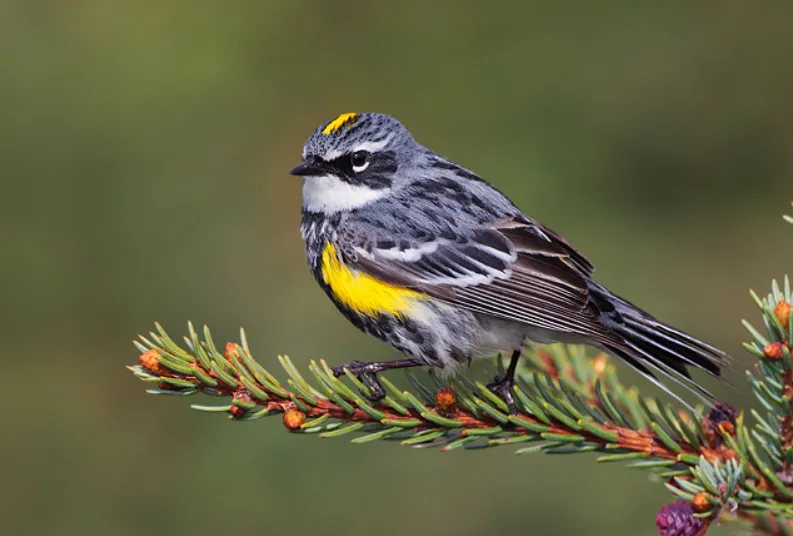
Yellow-rumped Warbler is a small songbird with yellow on its throat, rump, and shoulder. It has a dark gray head and wings with white wing bars. It is commonly found in open coniferous forests, especially near the edges or clearings where there are both conifers and deciduous trees.
Its diet consists mainly of insects and berries. In the winter, it will also eat suet and seed from bird feeders.
The average size of this bird is 4 to 5 inches in length with a wingspan of 7 to 8 inches.
In terms of behavior, they can often be seen flitting quickly through tree branches or hovering while picking insects off leaves. Yellow-rumped Warblers are known for their ability to thrive in a variety of habitats and adapt to different environments. They are also early migrants, often leaving their breeding grounds in Canada and the northern United States before other warbler species.

Cedar Waxwing
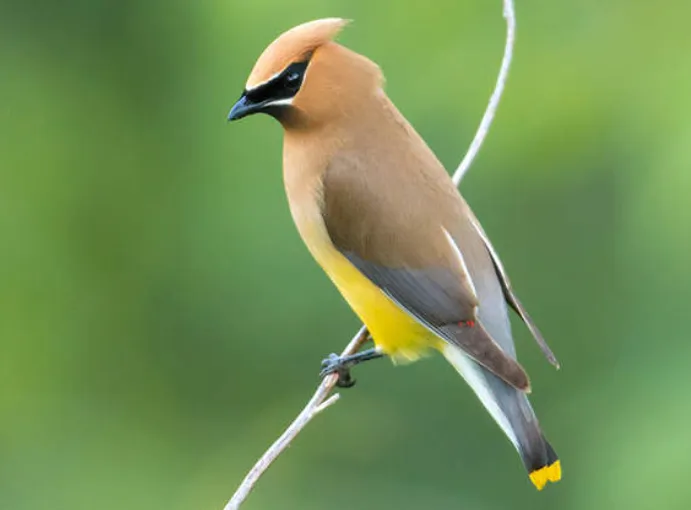
Cedar Waxwings birds can be identified by their sleek, tan bodies with black and white wingtips and a distinct yellow-tipped tail. They have a small, pointed bill that they use to eat insects, fruit, and berries.
In Wyoming, Cedar Waxwings can typically be found in open woodlands or urban areas with trees. These social birds are often seen in large flocks, but will also gather in smaller groups to feed or build nests.
On average, Cedar Waxwings measure 7-8 inches in length and have a wingspan of 12-13 inches. They are agile flyers and use their swift movements to catch insects midair.
During breeding season, male Cedar Waxwings will perform aerial displays, diving and soaring to attract a mate. These birds are also known for their habit of “wanting,” where they will spread ants on their feathers as a form of insect control.
Cedar Waxwings are highly adaptable and can be found across North America, but their populations have been declining in recent years due to loss of habitat and pesticide use.

House Sparrow
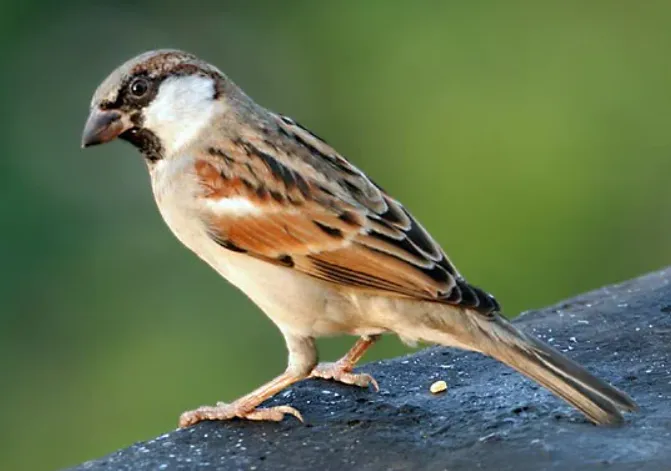
House sparrows, native to Europe and Asia, can be found throughout Wyoming. These small birds have brown bodies with white underneath, a black bib on the chest, and a grey crown on top of their heads.
Their diet consists mainly of seeds and grains, but they will also eat insects and even other small animals.
These birds typically reach lengths of around 6 inches and weigh 1.5 ounces.
They can be found in a variety of habitats, including cities, farms, grasslands, and open woodlands.
House sparrows typically live in large flocks and can often be seen gathering at bird feeders or on electrical wires. They are known to aggressively compete for food and nesting sites.
They build their nests in holes or crevices, often taking over the nests of other bird species.
They are considered pests by some due to their aggressive behavior and tendency to destroy crops. Despite this, they are a commonly seen backyard bird and contribute to controlling insect populations.

Black-billed Magpie

Black-billed Magpie is a large bird with black and white plumage, a long tail, and a distinctive black bill. It can be found in open habitats such as grasslands and scrublands in Wyoming.
The diet of the Black-billed Magpie consists mainly of insects, small vertebrates, carrion, and garbage. They are also known to steal food from other animals.
Adult Black-billed Magpies have a length of about 17 inches and a wingspan of around 24 inches.
In addition to foraging and nesting solo or in small groups, Black-billed Magpies are known for their intelligence and problem-solving abilities. They have been observed using tools and engaging in play behavior. They are also known for their loud, harsh calls.

Belted Kingfisher

(Megaceryle alcyon) can be identified by its large size, blue back and wings, white chest, and a black band across its belly.
This bird primarily eats fish but will also eat insects, crustaceans, and amphibians. They typically measure around 12 inches in length with a wingspan of 21 inches. Belted Kingfishers can be found near bodies of water such as lakes, rivers, and marshes.
They perch on branches or poles overlooking the water before diving down to catch their prey. They also nest in burrows along banks or in wetlands. These birds are solitary and territorial, often seen chasing away other birds from their hunting grounds.
Belted Kingfishers can be found year-round in Wyoming, though their numbers may fluctuate with the seasons.

Vesper Sparrow
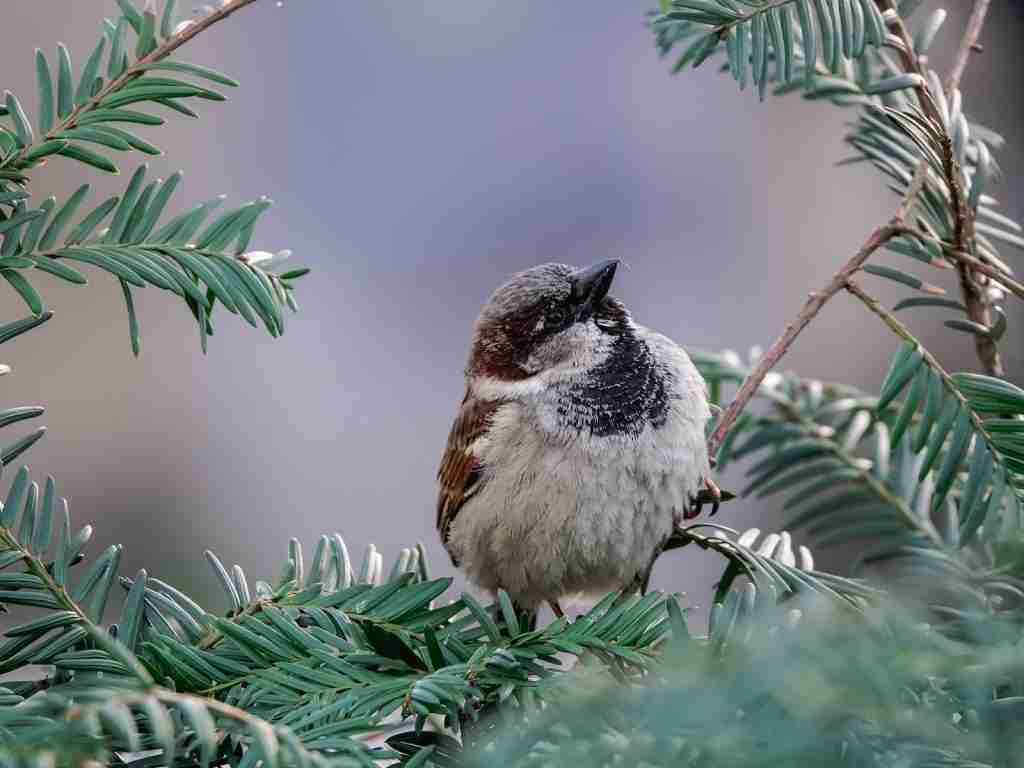
Vesper Sparrows can be identified by their streaked brown back, white underbelly, and distinct white eyebrow. They mainly eat seeds and insects. Adults are typically six inches in length. These birds can be found in grasslands and open fields in Wyoming. They tend to be shy and will often hide among tall vegetation or perch on top of shrubs and fences.
Their song consists of a few clear whistles followed by a trill. During breeding season, males will perform flight displays to attract mates. They build cup-shaped nests on the ground, often lined with grasses and hair.
In winter, Vesper Sparrows may form flocks with other sparrow species and forage in agricultural fields. They are not currently threatened or endangered.
However, loss of grassland habitat due to development and agriculture can impact their populations. Conservation efforts such as the protection and restoration of native prairie habitats can aid in the survival of these small songbirds.

Eurasian Collared-Doves
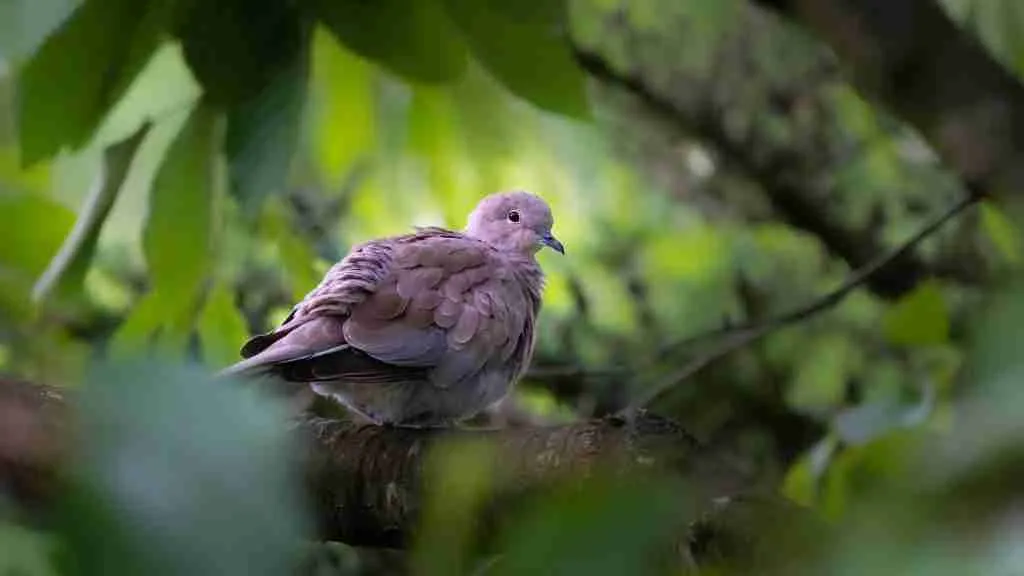
Eurasian Collared-Doves, also known as collared doves, have distinct black markings on the back of their neck and a small tuft of feathers on their head. These doves primarily eat seeds and grains, but will also consume insects and fruit.
They typically measure about 12-14 inches in length with a wingspan of 21-24 inches. Collared doves can be found in open habitats, such as fields and suburban areas, and are often seen perched on telephone wires or feeding on the ground. They tend to be more active during dawn and dusk, while spending the majority of their time foraging for food.
These doves do not migrate and can commonly be spotted year-round in Wyoming. In urban areas, they may form large flocks and can often be seen sharing feeding stations with other bird species.
In mating season, male collared doves perform a display of cooing and wing-flapping to attract a mate. They build their nests in trees or on building ledges and typically lay 2-3 eggs per clutch. Both the male and female participate in incubating the eggs and caring for the young hatchlings. These doves have a lifespan of about 9-12 years in the wild.

Warbling Vireos

Warbling Vireos can be identified by their grayish-olive upperparts, white underparts, and thin white wing bars. Their diets consist mainly of insects and berries. They typically measure around five inches in length and can be found in deciduous forests or riparian woodlands during the breeding season.
These birds are known for their loud, whistled songs and frequent hopping and flitting among the foliage. They also construct hanging nests made of twigs, grass, and rootlets.
During the non-breeding season, Warbling Vireos can be found in wooded areas throughout Mexico and Central America. They migrate to the western and southern parts of Canada, as well as the western United States, including Wyoming.

Blue Jays
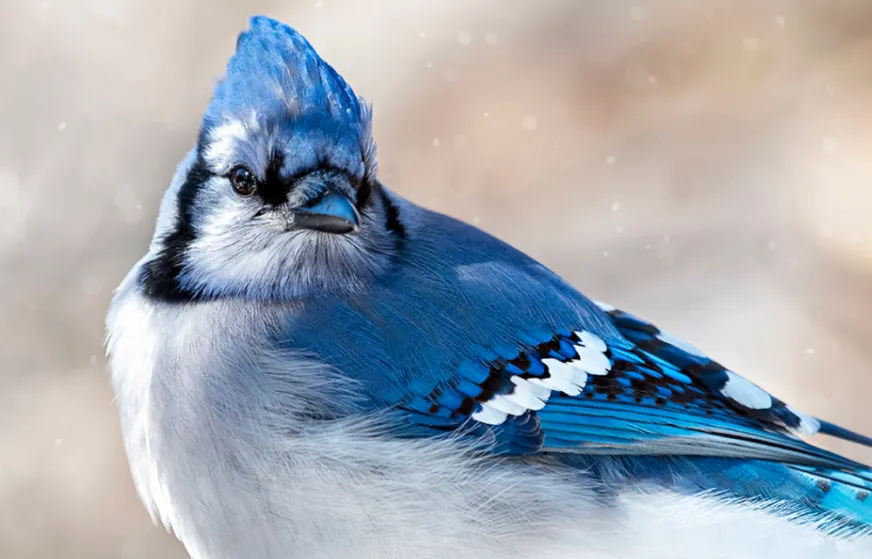
Blue Jays, known for their blue and white feathers and black-streaked neck, can be found in Wyoming’s forests and wooded areas. They are known to eat a variety of foods including nuts, seeds, insects, and even small vertebrates like frogs or lizards. On average, they measure around 10 inches in length and have a wingspan of roughly 13-17 inches.
In terms of behavior, Blue Jays are known to be loud and aggressive, often chasing away smaller birds from bird feeders. They are also known for their clever habits of storing food in tree crevices or burying it for later consumption.
Blue Jays typically mate for life and live in small family groups, with both parents taking care of the young hatched from their nest. They are also known for their mimicry abilities and have been observed imitating the sounds of hawks in order to scare away potential predators.

European Starlings
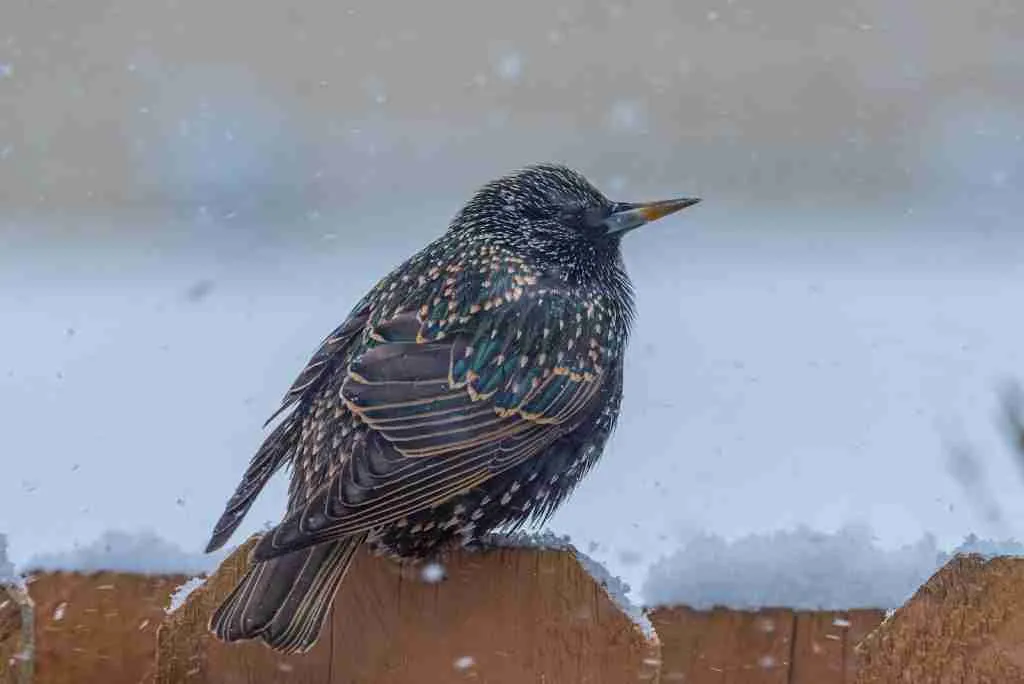
European Starlings are small birds, about the size of a sparrow, with glossy black feathers and white outer tail feathers. Their diet consists mainly of insects and fruits.
In Wyoming, they can be found in open fields and forest edges, often near human settlements.
They are known for their noisy and aggressive behavior, especially during nesting season when they will fiercely defend their territory.
They also have a remarkable ability to mimic sounds, including other bird calls and even human speech.
Introduced to North America in the late 1800s, European Starlings have adapted well and can now be found all across the continent.
Unfortunately, their success has led to problems with native bird species, as they compete for resources and contribute to the decline of some bird populations.
However, their varied diet and adaptability also make them important players in the ecosystem.

Brown-headed Cowbird
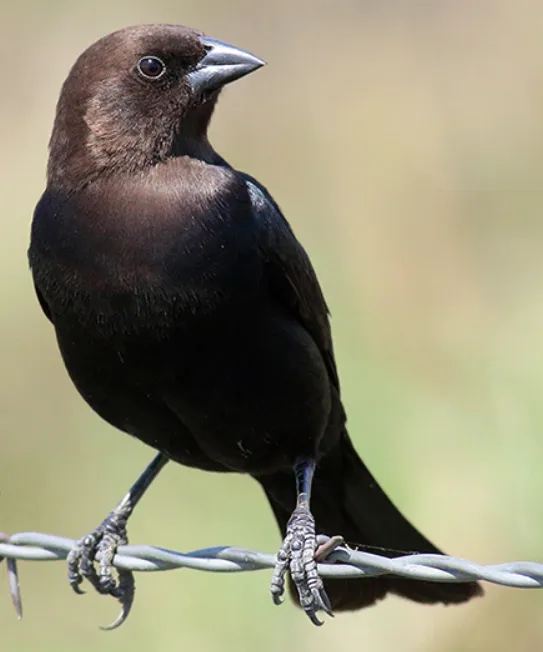
Brown-headed cowbirds are small blackbirds with distinct brown heads. They primarily feed on insects and seeds found on the ground.
In Wyoming, they can be found in open grasslands and agricultural fields.
Their behavior is often described as parasitic, as they will lay their eggs in the nests of other bird species, leaving the host parents to raise their young.
This behavior has caused declines in the populations of some native birds. Conservation efforts have focused on protecting the nests of these host species and reducing cowbird numbers through controlled removal programs.

Chipping Sparrow
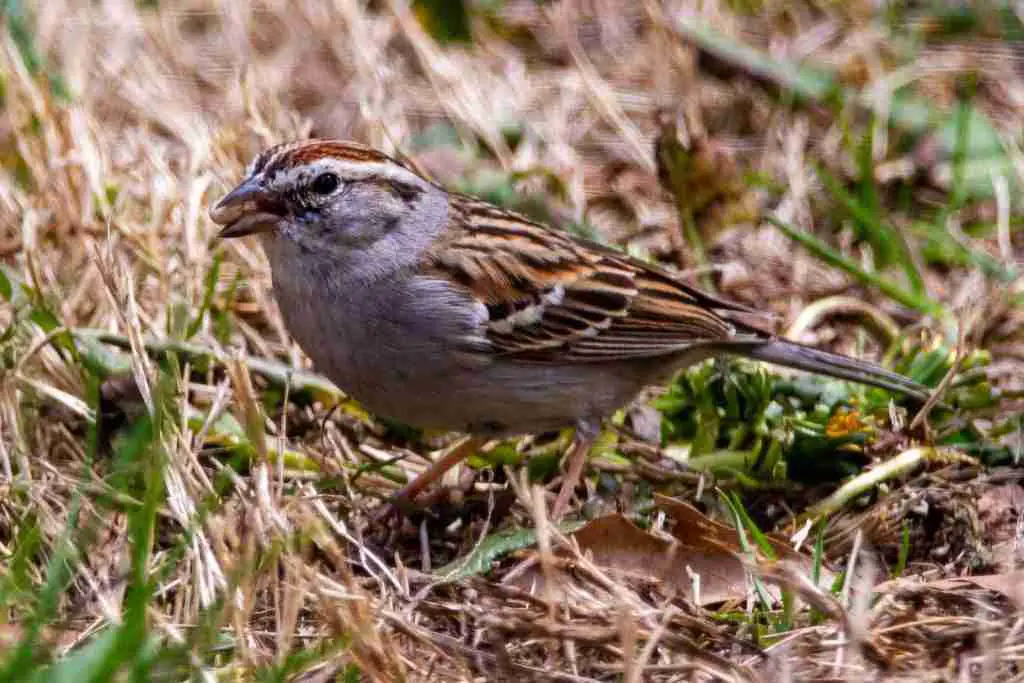
Chipping Sparrows, found in Wyoming, can be identified by their brown upperparts, white underparts, black stripe on the crown of their head, and reddish-brown streak on their cheeks. They mainly eat seeds and insects.
These sparrows are small birds, typically measuring around 5 inches in length. They can be found in open woodlands and grasslands. Chipping Sparrows are often found in flocks and can be seen hopping on the ground to forage for food. They also construct cup-shaped nests in trees or shrubs, where they will lay their eggs.
In winter, they may form mixed flocks with other sparrow species and often visit bird feeders. Their song is a series of thin, high-pitched chips. These birds also have an unmistakable flight call, sounding like a sharp “tsee-d” or “tsee-ip.”
These sparrows are native to North America and can be found year-round in Wyoming, though some may migrate to southern regions during the winter months.

Black-capped Chickadees
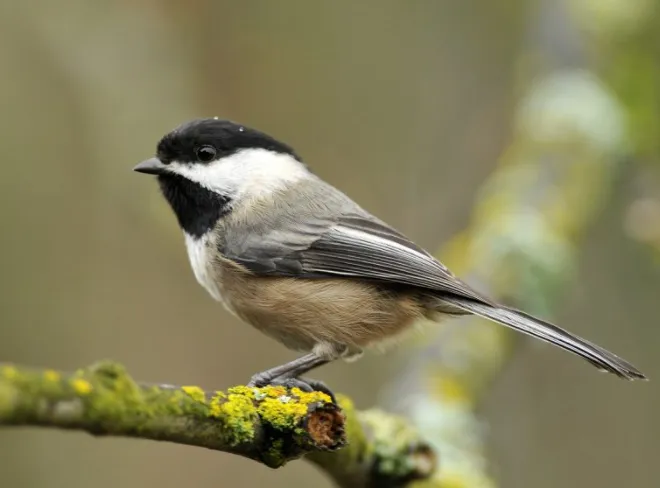
Black-capped Chickadees can be identified by their black cap and bib, white cheeks, and gray wings and body. They mainly eat insects, seeds, and suet.
These small birds typically measure about 4-5 inches in length.
In Wyoming, they can be found in coniferous or mixed forests near shrubs or trees.
These chickadees are known for their bold and curious behavior, often seen hanging upside down or chasing after other birds to steal food. They also have a distinctive call, sounding like “chick-a-dee-dee-dee.”
During the winter months, they will form flocks with other chickadees and woodpeckers while foraging for food.
They have also been observed caching food, such as seeds, for later consumption.

American Robin
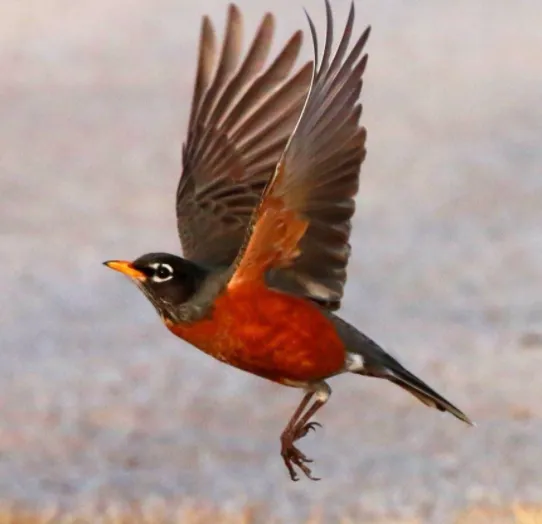
(Turdus migratorius) can be identified by its dark brown back, reddish breast, and white belly. In Wyoming, their diet consists of insects, fruits, and berries. Adult robins typically range from 9-11 inches in length with a wingspan of 12-15 inches.
They can be found in a variety of habitats including forests, fields, and suburban areas.
In terms of behavior, robins often forage on the ground for food and are known for their iconic “cheer-up, cheerily, cheer up” song.
They also engage in territorial behaviors such as flicking their tails and singing loudly to defend their territory. Additionally, they form long term pair bonds and engage in cooperative breeding with other individuals helping to raise young.

Song Sparrow
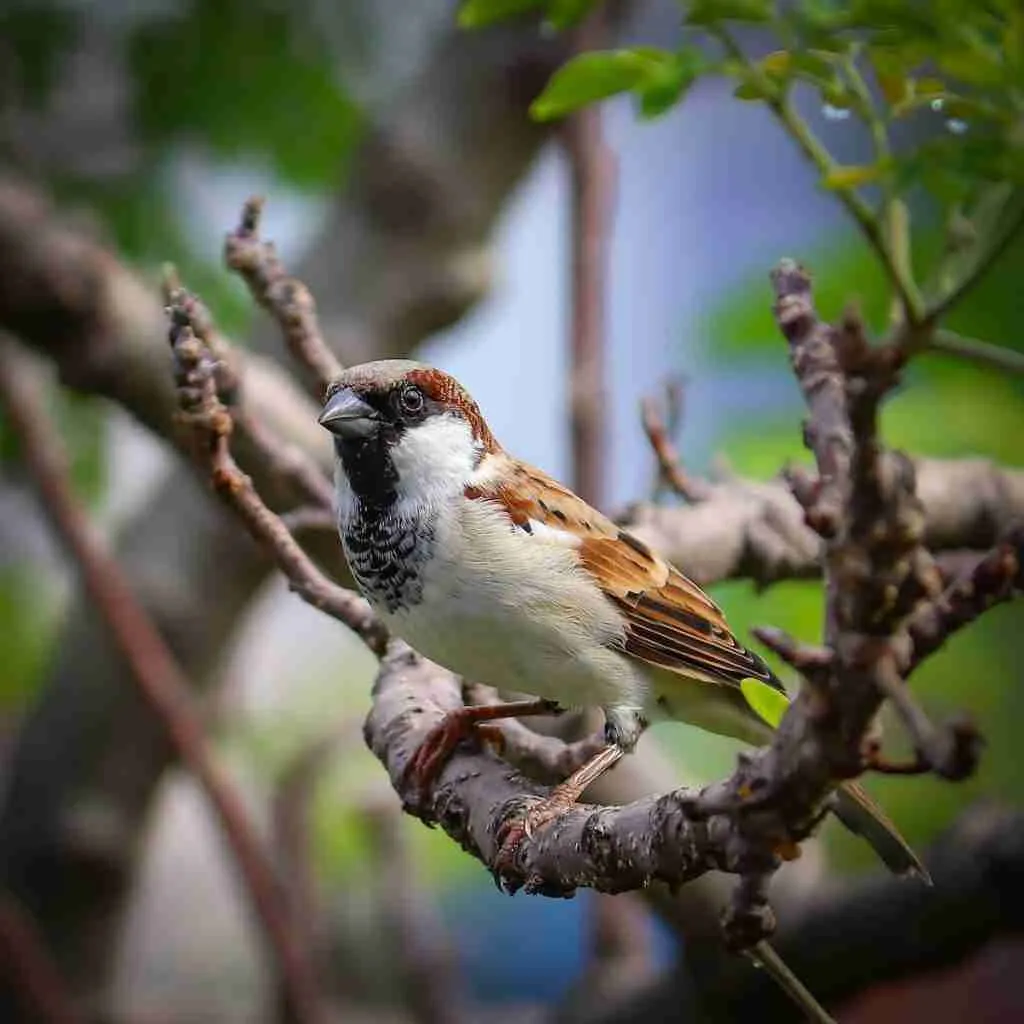
Song Sparrows are small birds with dull brown, streaked upperparts and a long, distinct central breast spot. Their diet consists of insects, seeds, and fruit. They can be found in open areas with brush or low vegetation, such as fields and suburbs. These birds have a habit of bobbing their tail up and down while foraging on the ground.
They also have a loud, varied song and will often sing from exposed perches. In Wyoming, Song Sparrows can be seen throughout the year in suitable habitat. These birds may form flocks during winter or migrate short distances to more favorable locations.

American Goldfinch
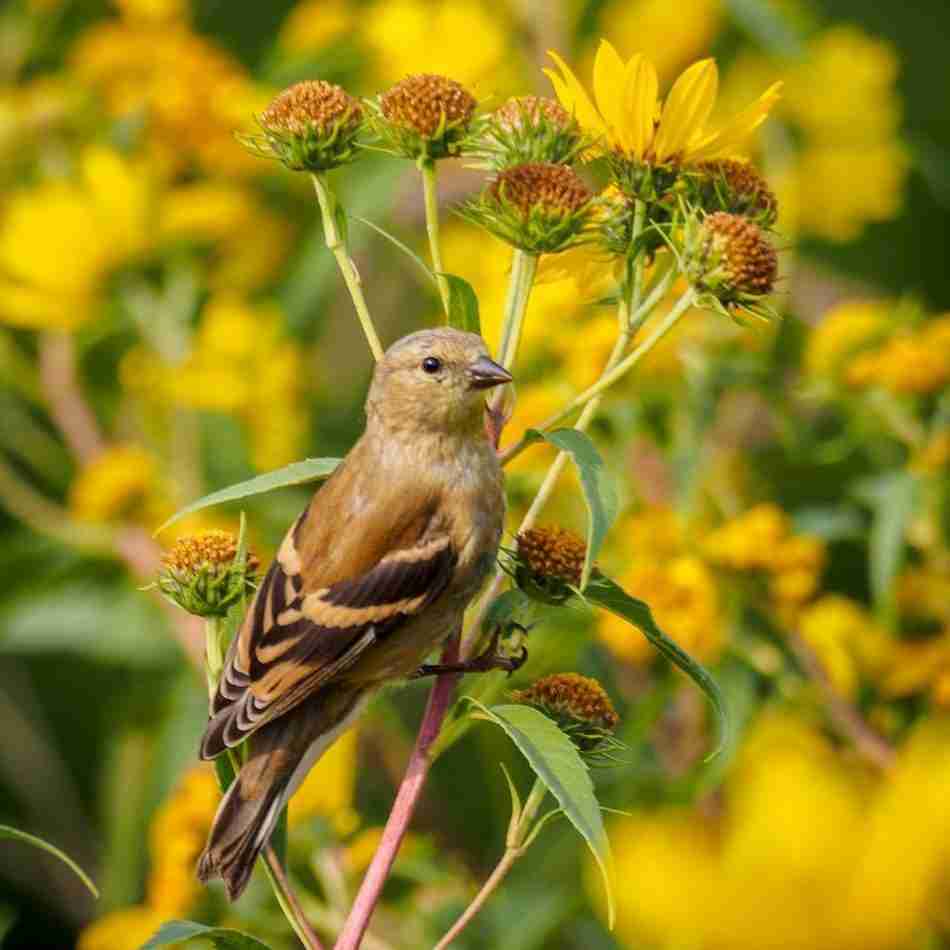
American Goldfinch, also known as the “Lightning Bird,” is easily identified by its bright yellow feathers and black wings.
These birds primarily feed on seeds and insects, often found at bird feeders or in open fields.
American Goldfinches typically reach sizes of 4-5 inches in length with a wingspan of 7-9 inches.
They can be found in a variety of habitats, from forests and grasslands to urban areas.
During breeding season, American Goldfinches are known for their energetic mating displays and singing abilities. They often form large flocks during winter months and migrate south for the colder seasons.

American Crow
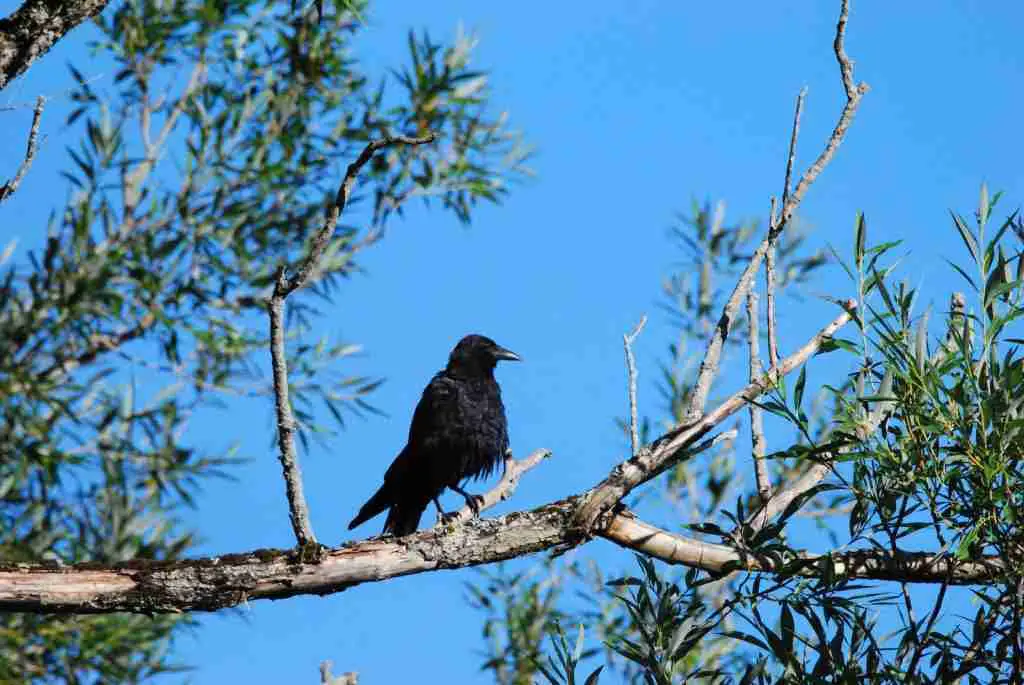
(Corvus brachyrhynchos) can be identified by their black feathers, distinct cawing call, and curved bill. In Wyoming, they can be found in a variety of habitats including forests, fields, and suburban areas.
Their diet consists mainly of insects, grains, fruits, garbage, small animals and eggs/nestlings of other bird species. They have also been known to team up with other American Crows to hunt small mammals, such as rabbits.
The average American Crow measures 17-21 inches in length and has a wingspan of 33-39 inches.
In terms of behavior, they are highly social birds often seen in large flocks. They are also very intelligent, known for their problem-solving abilities and ability to use tools. American Crows can live up to 14 years in the wild.

Downy Woodpecker
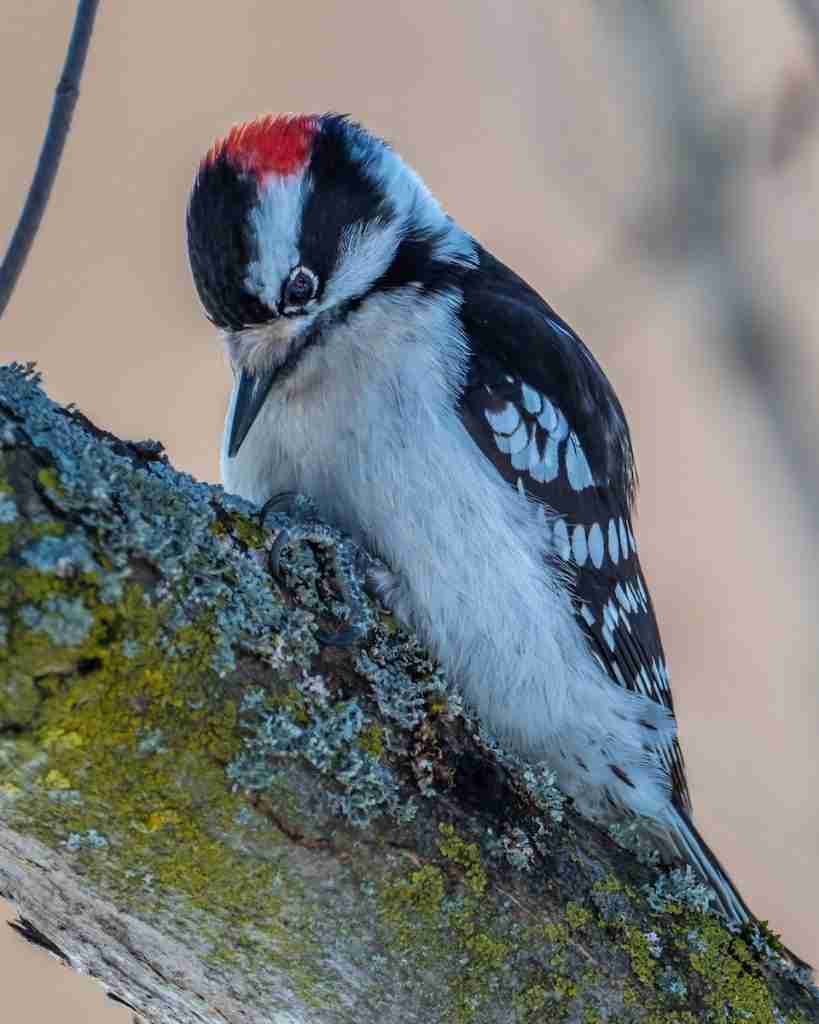
Downy Woodpecker is a small black and white bird with a distinct white bar on its wings, a black tail, and a spotted red patch on the back of its head. Its diet consists primarily of insects and tree-dwelling larvae, which it obtains by probing tree bark or catching in midair.
In Wyoming, Downy Woodpeckers can be found in a variety of wooded habitats, including coniferous and deciduous forests. They also commonly inhabit parks and residential areas with mature trees.
In terms of behavior, Downy Woodpeckers often form long-term pairs and stay together year-round. They are also known for their drumming on tree trunks, which serves both as a form of communication and for creating nesting cavities. Additionally, these birds are acrobatic and capable of hanging upside down on tree trunks while foraging.

What birds are common in Wyoming?
Some common birds found in Wyoming include American goldfinch, western meadowlark, mountain bluebird, northern flicker, and red-tailed hawk. Other bird species commonly seen in the state include sandhill crane, great horned owl, ring-necked pheasant, black-billed magpie, and bald eagle.
Wyoming also has a diverse array of waterfowl, including Canada goose, mallard, and green-winged teal. Migratory birds such as American white pelicans, sandhill cranes, and Wilson’s snipe can also be spotted in the state during certain times of year.
How many species of birds are in Wyoming?
According to a recent study, there are over 300 species of birds that have been recorded in the state. This includes both year-round residents and migratory species.
Some of the notable bird species found in Wyoming include bald eagles, western meadowlarks, great horned owls, and trumpeter swans.
What is the largest bird in Wyoming?
The trumpeter swan, with a length of up to 59 inches and a wingspan of up to 8 feet, is the largest bird found in Wyoming. These majestic birds can weigh up to 31 pounds and are known for their distinctive trumpeting call.
Trumpeter swans were once nearly hunted to extinction for their feathers, but conservation efforts have allowed their populations to rebound in Wyoming and across the United States.
These beautiful birds can often be seen near bodies of water, where they feed on aquatic plants and small animals.
Do Magpies live in Wyoming?
The answer is yes, magpies can be found in Wyoming and throughout the western United States. While they may not be as common as other bird species, they can often be spotted in open meadows or near forests and rivers.
Interestingly, magpies have a unique social structure where they form long-term bonds with their mates and also live in large groups called “clans.”

An avid ornithologist, zoologist and biologist with an unwavering passion for birds and wild animals.
Dr. Wilson’s journey in ornithology began in childhood and led him to obtain a Ph.D. in Ornithology from the prestigious Avian Research Institute. He has worked closely with renowned experts in the field and conducted extensive research and field studies globally.


